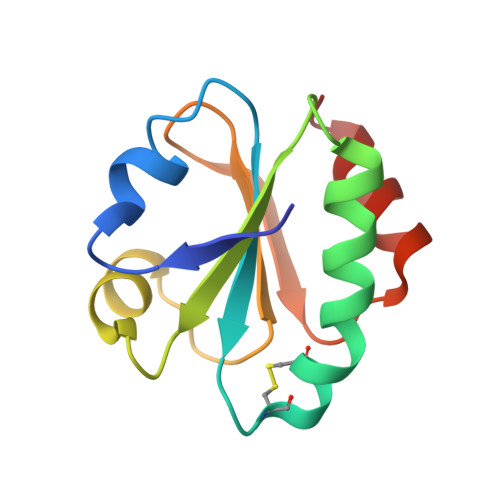Mutational Studies on Resurrected Ancestral Proteins Reveal Conservation of Site-Specific Amino Acid Preferences Throughout Evolutionary History.
Risso, V.A., Manssour-Triedo, F., Delgado-Delgado, A., Arco, R., Barroso-Deljesus, A., Ingles-Prieto, A., Godoy-Ruiz, R., Gavira, J.A., Gaucher, E.A., Ibarra-Molero, B., Sanchez-Ruiz, J.M.(2015) Mol Biol Evol 32: 440
- PubMed: 25392342
- DOI: https://doi.org/10.1093/molbev/msu312
- Primary Citation of Related Structures:
4ULX - PubMed Abstract:
Local protein interactions ("molecular context" effects) dictate amino acid replacements and can be described in terms of site-specific, energetic preferences for any different amino acid. It has been recently debated whether these preferences remain approximately constant during evolution or whether, due to coevolution of sites, they change strongly. Such research highlights an unresolved and fundamental issue with far-reaching implications for phylogenetic analysis and molecular evolution modeling. Here, we take advantage of the recent availability of phenotypically supported laboratory resurrections of Precambrian thioredoxins and β-lactamases to experimentally address the change of site-specific amino acid preferences over long geological timescales. Extensive mutational analyses support the notion that evolutionary adjustment to a new amino acid may occur, but to a large extent this is insufficient to erase the primitive preference for amino acid replacements. Generally, site-specific amino acid preferences appear to remain conserved throughout evolutionary history despite local sequence divergence. We show such preference conservation to be readily understandable in molecular terms and we provide crystallographic evidence for an intriguing structural-switch mechanism: Energetic preference for an ancestral amino acid in a modern protein can be linked to reorganization upon mutation to the ancestral local structure around the mutated site. Finally, we point out that site-specific preference conservation naturally leads to one plausible evolutionary explanation for the existence of intragenic global suppressor mutations.
Organizational Affiliation:
Departamento de Quimica Fisica, Facultad de Ciencias, Universidad de Granada, Granada, Spain.















